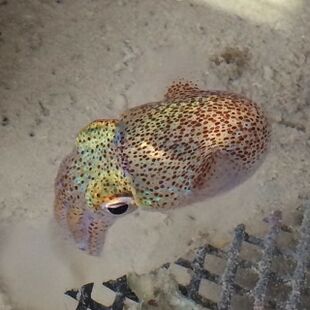Biology:Aposymbiosis
Aposymbiosis occurs when symbiotic organisms live apart from one another (for example, a clownfish living independently of a sea anemone). Studies have shown that the lifecycles of both the host and the symbiont are affected in some way, usually negative, and that for obligate symbiosis the effects can be drastic.[1] Aposymbiosis is distinct from exsymbiosis, which occurs when organisms are recently separated from a symbiotic association. Because symbionts can be vertically transmitted from parent to offspring or horizontally transmitted from the environment, the presence of an aposymbiotic state suggests that transmission of the symbiont is horizontal. A classical example of a symbiotic relationship with an aposymbiotic state is the Hawaiian bobtail squid Euprymna scolopes and the bioluminescent bacteria Vibrio fischeri. While the nocturnal squid hunts, the bacteria emit light of similar intensity of the moon which camouflages the squid from predators. Juveniles are colonized within hours of hatching and Vibrio must outcompete other bacteria in the seawater through a system of recognition and infection. [2]
Use in research
Aposymbiotic organisms can be used as models to observe a variety of processes. Aposymbiotic Euprymna juveniles have been studied throughout colonization in order to determine the system of recognizing Vibrio fischeri in seawater. Coral polyps without their symbiont algae are models for coral calcification and the effects of the algae on coral pH regulation.[3]
Aposymbiotic insects are used to model insect-bacteria relationships and modes of infection. These models are also used in arthropod vectors and disease transmission.[4] Wolbachia species are common insect endosymbionts and investigation into this species has yielded potential human health implications. Additionally, aposymbiotic wasps without Wolbachia are unable to reproduce.[5] This relationship between Asobara tabida wasps and Wolbachia is an important model for insect microbiome study.
Health
Women who are aposymbiotic for certain Lactobacillus species are more susceptible to urinary tract infections and bacterial vaginosis.[6] Additionally, these Lactobacilli are of interest for use as a probiotic therapeutic alternative to antibiotics.
Aposymbiotic vectors, especially insects, have been used to study disease transmission.[7] Furthermore, aposymbiotic and dysbiotic vectors are being engineered to change the rate and efficiency of disease transmission. Arthropod infection with Wolbachia can cause sterility and inhibit the transmission of vector-borne diseases.[8]
See also
References
- ↑ A. E. Douglas, Requirement of pea aphids (Acyrthosiphon pisum) for their symbiotic bacteria, Entomologia Experimentalis et Applicata (Historical Archive), Volume 65, Issue 2, Nov 1992, Pages 195–198
- ↑ Visick, Karen L.; McFall-Ngai, Margaret J. (2000-04-01). "An Exclusive Contract: Specificity in the Vibrio fischeri-Euprymna scolopes Partnership" (in en). Journal of Bacteriology 182 (7): 1779–1787. doi:10.1128/JB.182.7.1779-1787.2000. ISSN 0021-9193. PMID 10714980.
- ↑ Ohno, Yoshikazu; Iguchi, Akira; Shinzato, Chuya; Inoue, Mayuri; Suzuki, Atsushi; Sakai, Kazuhiko; Nakamura, Takashi (2017-01-18). "An aposymbiotic primary coral polyp counteracts acidification by active pH regulation". Scientific Reports 7: 40324. doi:10.1038/srep40324. ISSN 2045-2322. PMID 28098180. Bibcode: 2017NatSR...740324O.
- ↑ Ramasamy, M. S.; Ramasamy, R. (1990). "role of host immunity to arthropod vectors in regulating the transmission of vector borne diseases" (in English). Insect Science and Its Application. ISSN 0191-9040. http://agris.fao.org/agris-search/search.do?recordID=US201302666843.
- ↑ Boulétreau, Michel; Hochberg, Michael E.; Loppin, Benjamin; Fleury, Frédéric; Vavre, Fabrice; Dedeine, Franck (2001-05-22). "Removing symbiotic Wolbachia bacteria specifically inhibits oogenesis in a parasitic wasp" (in en). Proceedings of the National Academy of Sciences 98 (11): 6247–6252. doi:10.1073/pnas.101304298. ISSN 1091-6490. PMID 11353833. Bibcode: 2001PNAS...98.6247D.
- ↑ Servin, Alain L.; Graf, Federico; Grob, Philipp; Brassart, Dominique; Atassi, Fabrice (2006-12-01). "Lactobacillus strains isolated from the vaginal microbiota of healthy women inhibit Prevotella bivia and Gardnerella vaginalis in coculture and cell culture" (in en). FEMS Immunology & Medical Microbiology 48 (3): 424–432. doi:10.1111/j.1574-695X.2006.00162.x. ISSN 0928-8244. PMID 17059467.
- ↑ Saldaña, Miguel A; Hegde, Shivanand; Hughes, Grant L (2017). "Microbial control of arthropod-borne disease". Memórias do Instituto Oswaldo Cruz 112 (2): 81–93. doi:10.1590/0074-02760160373. ISSN 0074-0276. PMID 28177042.
- ↑ Slatko, Barton E.; Luck, Ashley N.; Dobson, Stephen L.; Foster, Jeremy M. (2014-07-01). "Wolbachia endosymbionts and human disease control" (in en). Molecular and Biochemical Parasitology 195 (2): 88–95. doi:10.1016/j.molbiopara.2014.07.004. ISSN 0166-6851. PMID 25046729.
 |


